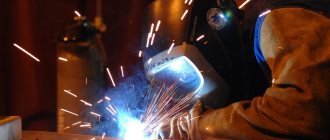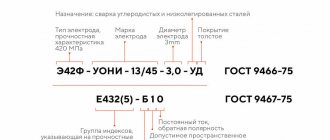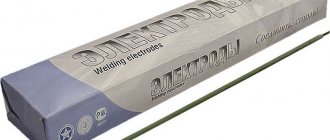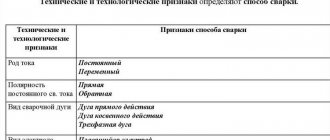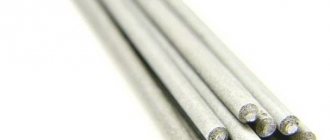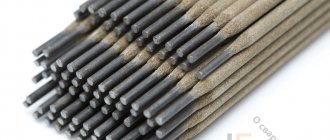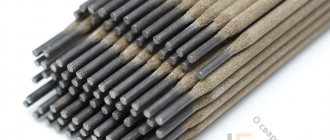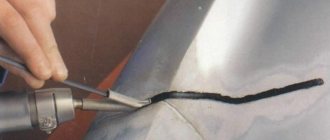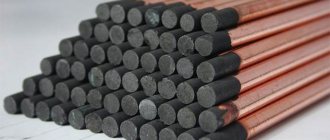The coating of welding electrodes is necessary for the weld to be of high quality and have the desired properties. It protects the connection from oxidation, pores and cracks.
The coating consists of several components that have the form of a powder and are connected using binders.
There are several types of coatings. We will look at the characteristics and composition of cellulose coating.
Composition and examples of cellulose electrodes
An electrode is a rod on which a special coating is applied. Its function is to protect the weld pool from compounds and excessive inclusions. Isolation of the working area allows you to make the connection reliable, durable and resistant to various loads.
The cellulose coating contains:
- Organic compounds - about 50%. First of all, these are cellulose, flour and starch. It is these components that provide gas protection.
- Rutile concentrate.
- Marble, carbonates and aluminosilicates provide the formation of a slag crust during welding.
- Depending on the manufacturer, the coating may contain metal powders and ferroalloys.
The mechanical properties of the metal obtained by surfacing correspond to GOST E45 - 50.
Let's look at several models of electrodes of this type to get a more detailed idea of their properties.
VSC-4M
The rods are used for making root welds and hot passing pipe joints. With their help, steels with a low content of carbon and alloying components, whose strength is 590 MPa, are welded.
Electrodes allow you to create a seam that is resistant to pore formation. Before work, it is recommended to calcinate the rods at 60°C for an hour.
OMA-2
Electrodes are used when working with thin structures and products up to 3 mm thick and strength up to 410 MPa. They weld using direct or alternating current.
The advantage of the model is the ability to perform work on oxidized surfaces. They have little meltability, so they can only be used with thin materials.
TsTS-1
The products are used to work with carbon steels with a low level of alloying and strength up to 451 MPa. In this case, the seam turns out to be plastic and has good impact strength.
Electrodes are used for welding in difficult installation conditions. They are convenient for making ceiling and vertical connections. Both AC and DC current can be used.
Before work, it is necessary to calcinate for an hour at a temperature of about 110°C. Welding is performed with a short or medium arc.
Cellulose coating of electrodes
Electrodes with this type of coating are intended for manual arc welding. During the welding process they form good gas protection for the deposited metal. They are made according to the same principle as electrodes with other types of coatings: a powder mixture is applied to a metal rod.
Basic composition of cellulose coating:
- Organic compounds. They make up the majority of the mixture - up to 50%. These include cellulose, flour and starch. The role of these connections is to provide gas protection.
- A small amount of rutile concentrate can be used.
- Marble, carbonates, as well as aluminosilicates and other substances are used to provide slag protection during cooking.
- Metal powders and ferroalloys can also be added to alloy the weld metal.
Pros and cons of cellulose electrodes
The positive features of the rods are:
- Wide application. Welding is allowed in any position, which makes it possible to get to different places and perform installation of any complexity.
- High speed. You can make up to 25 m of seam per hour.
- Good seam welding.
- The metal is completely protected from hydrogen and oxygen.
- Easy slag separation.
Among the disadvantages, the following should be noted:
- Rough scales form on the surface of the seams. Because of this, they have to be processed by grinding.
- Combustion can produce large amounts of hydrogen, which can enter the weld and cause cracks.
- During operation, there is a strong splashing of metal - about 15%.
- Before work, you should always calcinate.
Advantages and disadvantages of coating
When burned, cellulose electrodes release a large volume of gases, including carbon monoxide. The weld pool is reliably protected from contact with air. The electric arc has a slightly oxidized atmosphere in which silicon is reduced. To prevent it from getting into the seam and forming cavities, silicon is deoxidized with manganese ore, which is added as an additive to the coating.
Positive properties and characteristics of cellulose coatings:
- welding with alternating and direct current;
- the arc lights up easily;
- high productivity, up to 50 mm/min;
- absence of harmful fumes;
- any position of the seam;
- slag is easily separated;
- no lack of penetration is formed;
- the root seam is clean;
- deeply melts the material being welded.
When welding pipelines with a multilayer seam, cellulose electrodes are used to apply the bottom layer to form a root bead on the reverse side.
High-alloy steels, especially chromium-nickel steels with low carbon content, are cooked after heating the joint to 200 ⁰C to avoid cold cracks.
Disadvantages include:
- strong splashing, up to 15% of metal is lost;
- increased amount of oxygen in the weld metal;
- formation of undercuts;
- the seam is formed with large scales;
- At low welding speeds, burns and overheating occur.
Welding with cellulose electrodes is characterized by a strong cracking sound, which characterizes spattering.
Figure 2 - Spatter when welding with cellulose coating
The concentration of cellulose in the coating is high. The calcination temperature should not exceed 120 ⁰C, it is better to use a lower one – 110 ⁰C. Moisture does not evaporate well. The coating can only be prevented from getting wet if the electrodes are stored correctly. They are stored in a dry room with a relative air humidity of less than 50% and a temperature above +15 ⁰C. Sudden temperature changes are not allowed. After calcination, cellulose-coated electrodes are stored in drying ovens at 80 ⁰C. Thermal canisters are used for transportation.
Where are electrodes used?
Cellulose coating is useful when working with low alloy steels. Due to their small diameter, they can be used in any installation. Most often they are used in pipeline assembly.
The main advantage of this type of coating, compared to other coatings, is the easy ignition of the arc and its stable combustion. Electrodes can operate on both direct and alternating current, but for better welding it is better to use direct current. In this case, there will be no undercuts or pores in the connection.
When working with such rods you need to remember:
- Cellulose coating is not suitable for welding hardenable steels with a high content of carbon and alloying components.
- When preparing electrodes, the temperature and calcination time must exactly correspond to the parameters indicated by the manufacturer on the packaging.
The electrodes must not be overheated. After drying, about 3-4% moisture should remain in them. If the calcination temperature is exceeded, a large amount of carbon will accumulate in the metal during welding.
In this video you can see the welding process with cellulose electrodes:
Cellulose coated electrodes
, according to GOST 9466-75 “Coated metal electrodes for manual arc welding and surfacing.
general technical conditions”, in the structure of the symbol of the electrodes are indicated by the index
-
C.
Cellulose base
coatings (TsTs-1, OMA-2, VSP-1, VSC-2, VSC-3, VSC-4A, VSC-60, etc.) consist of flammable organic substances (cellulose, grass meal), which, when decomposed in an arc, create a large number of protective gases that protect the metal of the weld pool from saturation with atmospheric gases.
Electrodes with cellulose coatings are characterized by a low content of slag-forming materials (rutile, aluminosilicates, carbonates, etc.) and a moderate coating thickness.
A large amount of organic substances in the coating leads, during their decomposition, to the formation in the arc of not only protective gases, but also hydrogen. This causes significant hydrogenation of the weld metal, which is unacceptable when welding hardening steels with a high content of carbon and alloying elements, since due to the diffusion of hydrogen into the heat-affected zone from the weld, the metal becomes embrittled and preconditions are created for the formation of cold cracks.
Weld metal made with electrodes with organic gas-protective coatings is also prone to the formation of hot cracks when the carbon and sulfur content in the steel being welded is high.
To the advantages
These electrodes include a small amount of slag formed and good gas protection of the metal, which makes it easy to weld without slagging and without the formation of pores in the seams in the absence of strict requirements for the quality of assembly in terms of gaps.
When welding, a conical bushing from the unmelted coating is formed at the end of the electrode, which promotes the formation of a gas flow that pushes the liquid metal of the weld pool out from under the arc and ensures deeper penetration of the base metal. This is especially important when welding:
- root layers of pipeline seams with guaranteed penetration and the formation of a uniform back bead;
- other structures in installation conditions;
- when one-sided welding on weight.
Good arc stability, suitability for manual arc welding with alternating current, ability to make seams in any spatial position
(fusion welding provisions - GOST 11969-79) and the other technological advantages listed above ensure the widespread use of electrodes with cellulose coatings, mainly in the construction of main pipelines made of low-carbon steels.
Electrodes with cellulose coating (grades VSC-4A, etc.) are used for welding the root seam of fixed pipeline joints using the top-down method of support at a welding speed of up to 25 m/h.
When welding pipelines made of high-strength low-alloy steels, these electrodes are recommended for welding only root seams.
Application
Cellulose-coated electrodes are used for welding carbon and low-alloy steels. Their small thickness allows them to be used when working with hard-to-reach structures. Often used for welding main pipelines.
The cellulose coating ensures stable burning of the welding arc both at alternating and direct current. But for better welding, it is recommended to use a current of direct polarity. This way the arc will melt the metal more powerfully, eliminating the possibility of undercuts and pores forming.
When using cellulose electrodes, several nuances should also be taken into account:
- You cannot weld structures made of hardening steels that contain a lot of carbon and alloying elements;
- When preparing electrodes for work, they must be calcined strictly at the temperature specified by the manufacturer.
IMPORTANT! The electrodes must not be overheated during calcination, since they must maintain a humidity level of 1.5 to 5.0%.
If the electrodes are heated at temperatures above 170 °C, they become significantly overdried. As a result, the deposited metal will be more saturated with carbon.
The optimal calcination temperature is 120-130 °C.
Characteristics
- The deposited metal corresponds to mild or semi-mild steel.
- In terms of the mechanical properties of welded joints, the cellulose coating corresponds to electrodes of grade E42-50 (according to GOST).
- Low-oxidizing atmosphere of the welding arc.
Benefits of coverage
- Wide possibilities of use. Welding can be carried out in any spatial position. It is convenient to weld structures in hard-to-reach places, since the electrodes are very thin.
- Provides high speed. The welder can work at speeds of up to 25 m/hour due to the ease of welding.
- High-quality welding of the seam to the very root.
- Gas protection protects the deposited metal from the influx of hydrogen or oxygen.
- During cooking, a little slag is released. This makes it convenient to weld vertical seams, since the slag does not flow down and interfere with work. Slag is easily removed from the surface of a cooled seam.
Flaws
- The seams are obtained with a rough-scaled surface. Therefore, additional grinding of the metal of the welded structure may be necessary.
- The ductility of the weld metal decreases, since the combustion of organic compounds releases a large amount of hydrogen, which will also be in the deposited metal. May cause cracks.
- During welding, strong metal spattering is observed (up to 15%).
- Sensitive to overheating during the calcination process.
